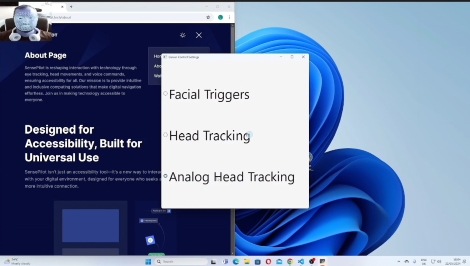Creating accessible, personalisable methods to control a computer for users with low mobility via head and gesture tracking and other features using only an existing webcam.

As part of a hackathon with a team in AI Lithuania, we were able to build a product in a short time and successfully pitch to the jury, landing 2nd prize in the competition.
I researched the current competing technologies and scoped out the current market conditions; this led to uncovering that current solutions often required costly additional equipment like webcams or a good level of tech knowledge to implement. Much of the headtracking market focused on gaming rather than accessibility requirements. Through conducting user research, we could see that much more still needed to be done to create an affordable and viable solution.
The research also showed various potential business models for the technology. Typical would be B2C where a user downloads and installs the program - a subscription model would work well for this so that updates can be continuously rolled out to users where iterations have been made. Low friction to install and customise is important for the product as it may be set up with the aid of a care worker or family member. Alternative channels would be B2B2C where a user would gain access through their care network, such as charities or health services - many of the current more expensive setups are purchased through such channels.
These are key to the success of the product in solving problems, as individuals have their own range of abilities. As these differ from person to person, being able to select and adapt which gestures work best for their abilities or the sensitivity of the cursor to head movements. We were also able to create modes for the head tracker, where users could select which mode worked best for them; the standard mode where the cursor moves along with head movements or analog, where the user can move the cursor to where they want and then return to a ‘normal’ position and the cursor would remain where it was (similar to a joystick).
We sought to create a low friction solution where a user could easily download and install and then begin customising and calibrating according to their preferences.
Through interviewing users in the UK, the main way they access solutions is via the Electronic Assistive Technology service, which is a part of each local NHS trust - this highlighted the B2B2C channel for the product. Outside of the UK though, it is dependent on each country if their health services offer similar services, without these, it is up to users to find and source their own solutions.
Users had tried a few different competitors’ solutions and experienced issues with lag and stability, where the cursor doesn’t move smoothly across the screen and also many issues with different lighting conditions, where in backlit or lowlight conditions, the head tracking was considerably less accurate. These are opportunities that we can try to resolve with our solution.